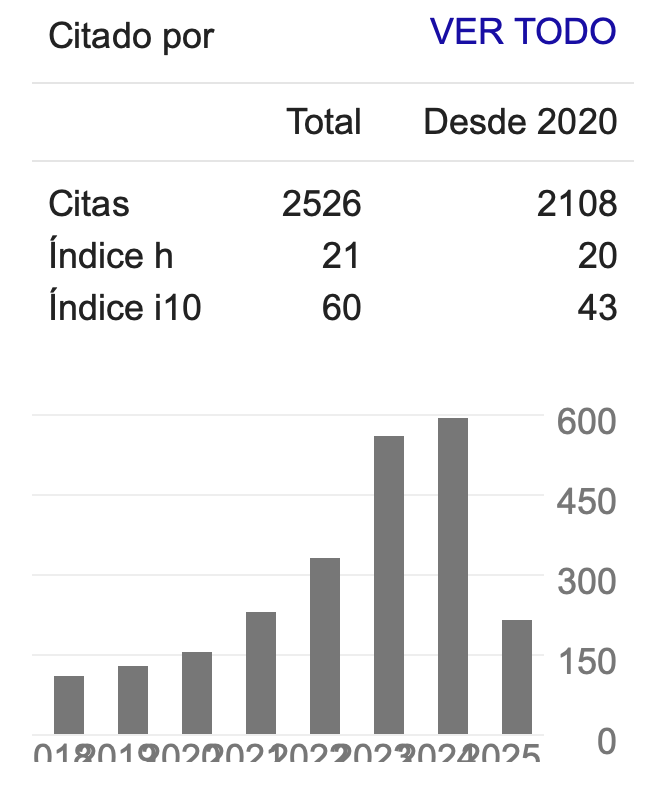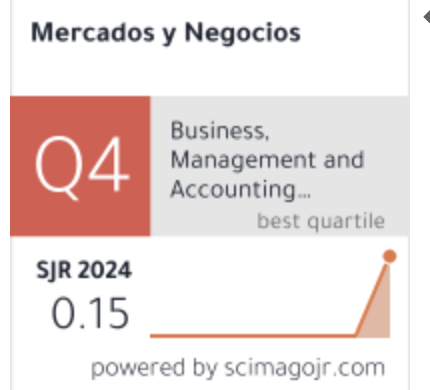Adopción de APPs móviles para el servicio de taxi en México
DOI:
https://doi.org/10.32870/myn.v0i39.7275Keywords:
aplicaciones móviles, servicio de taxi, influencia social, riesgo percibido, calidad de diseño, calidad de la información, calidad del sistemaAbstract
El objetivo principal de este trabajo es analizar los factores que influyen en la intención de continuar con el uso de las aplicaciones para solicitar el servicio de taxi privado entre los jóvenes de la ciudad de Guadalajara, Jalisco, México. Se centra en las relaciones entre la calidad de la información, calidad del sistema, calidad del diseño de la interfaz, influencia social y el riesgo percibido. En total se recolectaron 144 respuestas válidas para el análisis de regresión múltiple. Los resultados indican que la calidad del diseño del interfaz, la influencia social y el riesgo percibido son predictores influyentes en la intención de continuar el uso de este tipo de aplicaciones móviles.References
Abrahamson, E., Rosenkopf, L. (1997). Social network effects on the extent of innovation diffusion: A computer simulation, Organization Science, 8(3), 289-309. http://dx.doi.org/10.1287/orsc.8.3.289
Ajzen, I. (1991). The Theory of Planned Behavior. Organizational Behavior and Human Decision Processes, 50, 179-211.
Ajzen, I. (2002). Perceived behavioral control, self-efficacy, locus of control, and the theory of planned behavior. Journal of Applied Social Psychology, 32, 665-683.
Ajzen, I. (2005). Attitudes, Personality and Behavior. (2ndedn), Open University Press.
Ajzen, I., Fishbein, M. (1980). Understanding attitudes and predicting social behaviour, Englewood Cliffs, New Jersey, Prentice-Hall.
Al Khasawneh, M., Shuhaiber, A. (2013). Comprehensive model of factors influencing consumer attitude towards and acceptance of SMS advertising: An empirical investigation in Jordan. International Journal of Sales & Marketing Management Research and Development, 3(2), 1-22.
Aladwani, A., Palvia, P. (2002). Developing and validating an instrument for measuring user perceived web quality. Information & Management, 39(6), 467–476.
Alsamydai, M., Khasawneh, M. (2013). Antecedents and consequences of E-Jordanian consumer behavior regarding Facebook advertising. International Journal of Business Management Research, 3, 41-59.
Bellman, S., Potter, R., Treleaven-Hassard, S., Robinson, J., Varan, D. (2011). The Effectiveness of BrandedMobile Phone Apps, Journal of Interactive Marketing, 25(4), 191–200.
Berendt, B., Günther, O, Spiekermann, S. (2005). Privacy in e-commerce: Stated preference vs. actual behavior. Communications of the ACM, 48, 101–106.
Bharati, P., Chaudhury, A. (2004). An empirical investigation of decision-making satisfaction in web-based decision support systems. Decision Support Systems, 37, 187–197.
Brown, I., Cajee, D. Daves, Stroebel, S. (2003). Cell phone banking: Predictors of adoption in South Africa—An exploratory study. International Journal of Information Management, 23, 381–394.
Campbell, D., Fiske, D. (1959). Convergent and discriminant validation by the multitrait-multime- thod matrix. Psychological Bulletin, 56, 81-105.
Castañeda, J., Muñoz-Leiva, F., Luque, T. (2007). Web Acceptance Model (WAM): Moderating effects of user experience. Information and Management, 44, 384-396.
Chiu, C., Hsu, M., Wang, E. (2006). Understanding knowledge sharing in virtual communities: an integration of social capital and social cognitive theories, Decision Support Systems, 42, 1872-1888. http://dx.doi.org/10.1016/j.dss.2006.04.001
Davis, F. (1989). Perceived usefulness, perceived ease of use, and user acceptance of information technology. MIS Quarterly, 13(3), 318–346.
Davis, F., Bagozzi, R., Warshaw, P. (1989). User acceptance of computer technology: A comparison of two theoretical models, Management Science, 35(8), 982-1003. http://dx.doi.org/10.1287/mnsc.35.8.982
De la Garza, G., Morales, S., González, C. (2013). Análisis estadístico multivariante. Un enfoque teórico y práctico. México: Mc Graw Hill Interamericana.
Deloitte (2016). Hábitos de los consumidores móviles en México 2016. México: Deloitte.
DeLone, W., McLean, E. (1992). Information systems success: the quest for the dependent variable. Information Systems Research, 3(1), 60–95.
DeLone, W., McLean, E. (2003). The DeLone and McLean model of information systems success: a ten-year update. Journal of Management Information Systems, 19(4), 9–30.
DeLone, W., McLean, E. (1992). Information systems success: The quest for the dependent variable. Information Systems Research, 3(1), 60–95.
DeLone, W., & McLean, E. (2003). The DeLone and McLean model of information systems success: A ten-year update. Journal of Management Information Systems, 19(4), 9–30.
Everard, A., Galletta, D. (2006). How presentation flaws affect perceived site quality, trust, and intention to purchase from and online store. Journal of Management Information Systems, 22(3), 55–95.
Fishbein, M., Ajzen, Belief, I. (1975). Attitude, intention and behavior: An introduction to theory and research. Addison-Wesley.
Fulk, J., Boyd, B. (1991). Emerging theories of communication in organizations, Journal of Management, 17(2), 407-446. http://dx.doi.org/10.1177/014920639101700207
Fung, R., Lee, M. (1999). EC-trust: exploring the antecedent factors. In: Haseman, W.D., Nazareth, D.L. (Eds.), Proceedings of the Fifth Americas Conference on Information Systems, August 13–15, 517–519.
Goh, T., Sun, S. (2014). Exploring gender differences in Islamic mobile banking acceptance. Electronic Commerce Research, 14, 435–458 DOI 10.1007/s10660-014-9150-7
Google (2011). The Mobile Movement: Understanding Smartphone Users, April, Recuperado de http://www.gstatic.com/ads/research/en/2011 TheMobile Movement.pdf. (Consultado el 17 de octubre de 2017).
Gopi, M., Ramayah, T. (2007). Applicability of theory of planed behavior in predicting intention to trade online: some evidence from a developing country, International Journal of Emerging Markets, 2(4), 348-360.
Greatorex, M., Mitchell, V. (1994). Modeling consumer risk reduction preferences from perceived loss data, Journal of Consumer Marketing, 15(4), 669-85.
Gu, J., Lee, S., Suh, Y. (2009). Determinants of behavioral intention to mobile banking. Expert Systems with Applications, 36(9), 11605-11616. doi: 10.1016/j.eswa.2009.03.024
Igbaria, M., Parasuraman, S., Baroudi, J. (1996). A motivational model of microcomputer Usage, Journal of Management Information Systems, 13(1), 127-143.
Informe Mobile en España y en el Mundo (2017). Digital marleting trends (ditrendia). Recuperado de http://www.amic.media/media/files/file_352_1289.pdf (Consultado el 30 de octubre de 2017).
Romi, I. (2015). Mapping E-banking Models to New Technologies. Journal Internet Banking Commerce, 20, 112. doi:10.4172/2165-7866.1000112
Jarvenpaa, S., Todd, P. (1997). Consumer reactions to electronic shopping on the world wide web. International Journal of Electronic Commerce 1(2), 59–88.
Jennex, M., Amoroso, D., Adelakun, O. (2004). E-commerce infrastructure success factors for small companies in developing economies, Electronic Commerce Research, 4, 263-286. http://dx.doi.org/10.1023/B:ELEC.0000027983.36409.d4
Kang, H., Lee, M., Lee, J. (2012). Are you still with us? A study of the post-adoption determinants of sustained use of mobile-banking services. Journal of Organizational Computing and Electronic Commerce, 22(2), 132-159.
Kim, E., Lin, J., Sung, Y. (2013). To App or Not to App: Engaging Consumers via Branded Mobile Apps. Journal of Interactive Advertising, 13(1), 53-65, DOI: 10.1080/15252019.2013.782780
Kim, G., Shin, B., Lee, H. (2008). Understanding dynamics between initial trust and usage intention of mobile banking. Information Systems Journal. OnlineEarly Articles.
Kleijen, M., Wetzels, M., De Ruyter, K. (2004). Consumer Acceptance of Wireless Finance. Journal of Financial Services Marketing, 2(1), 66-76.
Koenig-Lewis, N., Palmer, A., Moll, A. (2010). Predicting young consumers' take up of mobile banking services. The International Journal of Bank Marketing, 28(5), 410-432. doi: 10.1108/02652321011064917
Konana, P., Balasubramanian, S. (2005). The social-economic-psychological (SEP) model of technology adoption and usage: An application to online investing, Decision Support Systems, 39(3), 505-524. http://dx.doi.org/10.1016/j.dss.2003.12.003
Konerding, U. (1999). Formal models for predicting behavioral intentions in dichotomous choice situations. Methods of Psychological Research, 4, 1-32.
Kumar, R., Ravindran, S. (2012). An empirical study on service quality perceptions and continuance intention in mobile banking context in India. Journal of Internet Banking and Commerce. 17(1), 1-22.
Lam, T., Cho, V., Qu, H. (2007). A study of hotel employee behavioural intentions towards adoption of information technology, International Journal of Hospitality Management, 26(1), 49-65. http://dx.doi.org/10.1016/j.ijhm.2005.09.002
Laukkanen, T. (2007). Customer preferred channel attributes in multi-channel electronic banking. International Journal of Retail & Distribution Management, 35, 393–412.
Laukkanen, T., Lauronen, J. (2005). Consumer value creation in mobile banking services. International Journal of Mobile Communications, 3, 325–338.
Lee, K., Chung, N. (2009). Understanding factors affecting trust in and satisfaction with mobile banking in Korea: A modified DeLone and McLean’s model perspective. Interacting with Computers, 21, 385 - 392.
Lee, Y., Kim, J., Lee, I., Kim, H. (2002). A cross-cultural study on the value structure of mobile Internet usage: comparison between Korea and Japan. Journal of Electronic Commerce Research, 3(4), 227-239.
Li, T. (2013). Applying the Information System success model to mobile banking apps. A Thesis Submitted to the School of Graduate Studies of the University of Lethbridge in Partial Fulfillment of the Requirements for the Degree Master of Science in Management. Faculty of Management University of Lethbridge, Alberta, Canada.
Liao, Z., Landry Jr, R. (2000). An empirical study on organizational acceptance of new information systems in a commercial bank environment, System Sciences, 2000. Proceedings of the 33rd Annual Hawaii International Conference, January 4-7, 1-7.
Lin, H. (2008). Determinants of successful virtual communities: contributions from system characteristics and social factors, Information and Management, 45, 522-527. http://dx.doi.org/10.1016/j.im.2008.08.002
Lin, H. (2008). Determinants of successful virtual communities: contributions from system characteristics and social factors, Information and Management, 45, 522- 527. http://dx.doi.org/10.1016/j.im.2008.08.002
Lohse, G.L., Spiller, P. (1998). Electronic shopping. Communications of the ACM, 41(7), 81–87.
Lu, J., Yu, C., and Liu, C. (2005). Facilitating conditions, wireless trust and adoption intention. Journal of Computer Information Systems, 46(1), 17–24.
Luarn, P., Lin, H. (2005), Toward an understanding of the behavioral intention to use mobile banking. Computers in Human Behavior, 21(6), 873–891. doi:10.1016/j.chb.2004.03.003.
Luarn, P., Lin, H. (2005). Toward an understanding of the behavioral intention to use mobile banking. Computers in Human Behavior, 21(6), 873–891.
Luo, X., H. Li, J. Zhang, J. Shim. (2010). Examining multi-dimensional trust and multi-faceted risk in initial acceptance of emerging technologies: An empirical study of mobile banking services. Decision Support Systems, 49, 222–234.
McKnight, D., Choudhury, V., Kacmar, C. (2002a). The impact of initial consumer trust on intentions to transact with a web site: a trust building model. Journal of Strategic Information Systems,11, 297–323.
McKnight, D., Choudhury, V., Kacmar, C. (2002b). Developing and validating trust measures for e-commerce: an integrative typology. Information Systems Research, 13(3), 334–359.
Miniard, P. W., & Cohen, J. B. (1981). An examination of the FishbeinAjzen behavioral intentions model's concepts and measures. Journal of Experimental Social Psychology, 17, 309-339.
Mirvis, P., Sales, A., Hackett, E. (1991). The implementation and adoption of new technology in organizations: The impact on work, people and culture, Human Resource Management, 30(1), 113–139. http://dx.doi.org/10.1002/hrm.3930300107
Misic, M., Johnson, K. (1999). Benchmarking a tool for web site evaluation and improvement. Internet Research, 9(5), 383–392.
Nysveen, H., Pedersen, P., Thorbjornsen, H. (2005). Explaining intention to use mobile chat services: Moderating effects of gender, Journal of Consumer Marketing, 33(5), 247-256.
Palmer, J., (2002). Web site usability, design, and performance metrics. Information Systems Research, 13(2), 151–167.
Pavlou, P., Fygenson, M. (2005). Understanding and predicting electronic commerce adoption: An extension of the Theory of Planned Behaviour, MIS Quarterly, 30(1), 115-143.
Pavlou, P. (2002). What drives electronic commerce? A theory of planned behavior perspective. Best Paper Proceedings of the Academy of Management Conference, Denver, CO.
Poey, L., Arffin, Z. (2015). Consumers’ Intention to Use a Single Platform E-Payment System: A Study Among Malaysian Internet and Mobile Banking Users. Journal of Internet Banking and Commerce, 20(1). (http://www.arraydev.com/commerce/jibc/)
Purcell, K., Entner, R., Henderson, N. (2010), The Rise of Apps Culture, Pew Internet and American Life Project, http://www.pewinternet.org/2010/09/14/the-rise-of-apps-culture/
Püschel, J., Mazzon, J., Hernandez, J. (2010). Mobile banking: Proposition of an integrated adoption intention framework. The International Journal of Bank Marketing, 28(5), 389-409. doi: 10.1108/02652321011064908
Ramayah, T., Suki, N. (2006), Intention to use mobile PC among MBA students: implications for technology integration in the learning in the learning curriculum, UNITAR e-Journal, 1(2), 1-10.
Ramayah, T., Jantan, M., Noor M., Ling, K. (2003). Receptiveness of internet banking by Malasyan Consumers, Asian Academy of Management Journal, 8(2), 1-29.
Rammile, N., Nel, J. (2012). Understanding resistance to cell phone banking adoption through the application of the technology acceptance model (TAM). African Journal of Business Management, 6(1), 86.
Rivard, S., Poirier, G., Raymond, L., Bergeron, F. (1997). Development of a measure to assess the quality of user-developed applications. The DATA BASE for Advances in Information Systems, 28(3), 44–58.
Romi, I. (2013). Testing Delone and Mclean’s Model in Financial. American Academic & Scholarly Research Journal, 5, 121-129.
Shen, Y., Huang, C., Chu, CH. & Hsu, C. (2010). A benefit - cost perspective of the consumer adoption of the mobile banking system. Behavior & Information Technology, 29(5), 497 - 511.
Shen, Y., Huang, C., Chu, C., Hsu, C. (2010), A benefit–cost perspective of the consumer adoption of the mobile banking system. Behaviour & Information Technology, 29(5), 497–511
Shimp, T., Kavas, A. (1984), The theory of reasoned action applied to coupon usage. Journal of Consumer Research, 11(3), 795-809.
Siddhartha, D., Rik, P., Sanjay, F. (2011), Factors Affecting Behavioral Intentions towards Mobile Banking Usage: Empirical Evidence from India. Romanian Journal of Marketing, 1, 1-24.
Smith, J, Terry, D., Manstead, A., Louis, W., Kotterman, D., et al. (2008). The attitude behaviour relationship in consumer conduct: The role of norms, past behaviour, and self-identity. The Journal of Social Psychology, 148, 311-333.
Stone, R., Grønhaug, K. (1993). Perceived risk: further considerations for the marketing discipline. European Journal of Marketing, 27(3), 39-50.
Suoranta, M. (2003). Adoption of Mobile Banking in Finland, Doctoral Dissertation, Jyväskylä, Finland: University of Jyväskylä.
Sweeny, J., Soutar, G. (2001). Consumers perceived value: The development of a multiple item scale. Journal of Retailing, 77, 203-220.
Talukder, M., Quazi, A., Djatikusumo, D. (2013). Impact of social influence on individuals’ adoption of social networks in SMEs, Journal of Computer Science, 9(12), 1686-1694. http://dx.doi.org/10.3844/jcssp.2013.1686.1694
Talukder, M., Quazi, A., Sathye, M. (2014). Mobile Phone Banking Usage Behaviour: An Australian Perspective. AABFJ Special Issue on Financial Planning & Financial Instruments. 8(4), 83-104.
Taylor, S., Todd, P. (1995a). Assessing IT usage: the role of prior experience. MIS Quarterly, 19(4), 561-570.
Taylor, S., Todd, P. (1995b). Understanding information technology usage: A test of competing models. Information Systems Research, 6(2), 144–176.
Venkatesh, V., Brown, S. (2001). A longitudinal investigation of personal computers in homes: Adoption determinants and emerging challenges, MIS Quarterly, 25(1), 71-102. http://dx.doi.org/10.2307/3250959
Venkatesh, V., Morris, M., Davis, G., Davis, F. (2003). User acceptance of information technology: Toward a unified view. MIS Quarterly, 27(3), 425–478.
Venkatesh, V., Thong, J., Xu, X. (2012). Consumer acceptance and use of information technology: Extending the United Theory of Acceptance and Use of Technology. MIS Quarterly, 36(1), 157 - 178.
Wang, Y., Wang, Y., Lin, Y., Tang, T. (2003). Determinants of user acceptance of internet banking: An empirical study. International Journal of Service Industry Management, 14(5), 501–519.
Wu, J., Wang, S. (2005). What drives mobile commerce? An empirical evaluation of the revised technology acceptance model. Information & Management, 42, 719–729.
Yang, K. (2006). The Effects of Consumer Perceived Value and Subjective Norm on the Adoption of Mobile Data Services: A Cross-cultural Comparison of American and Korean Consumers. A Dissertation Presented for the Doctor of Philosophy Degree The University of Tennessee, Knoxville
Yu, C., Chantatub, W. (2016). Consumers´ resistance to use mobile banking: evidence from Thailand and Taiwan. International Journal of Electronic Commerce Studies, 7(1), 21-38, doi: 10.7903/ijecs.1375
Yu, T., Fang, K. (2009). Measuring the Post-Adoption Customer Perception of Mobile Banking Services. CyberPsychology & Behavior. 12(1). Doi: 10.1089/cpb.2007.0209
Yung-Cheng, S., Chun-Yao, H., Chia-Hsien, C., Chih-Ting, H. (2010). A benefit-cost perspective of the consumer adoption of the mobile banking system. Behaviour & Information Technology, 29(5), 497-511. doi:10.1080/01449290903490658
Zhao, A., Hanmer-Lloyd, S., Ward, P., Goode, M. (2008). Perceived risk and Chinese consumers’ internet banking services adoption, International Journal of Bank Marketing, 26(7), 505-25.
Downloads
Published
How to Cite
Issue
Section
License
Mercados y Negocios by Department of Mercadotecnia y Negocios Internacionales. University of Guadalajara is licensed under a License Creative Commons Attribution-NonCommercial 4.0 International.
The author retains the copyright.








